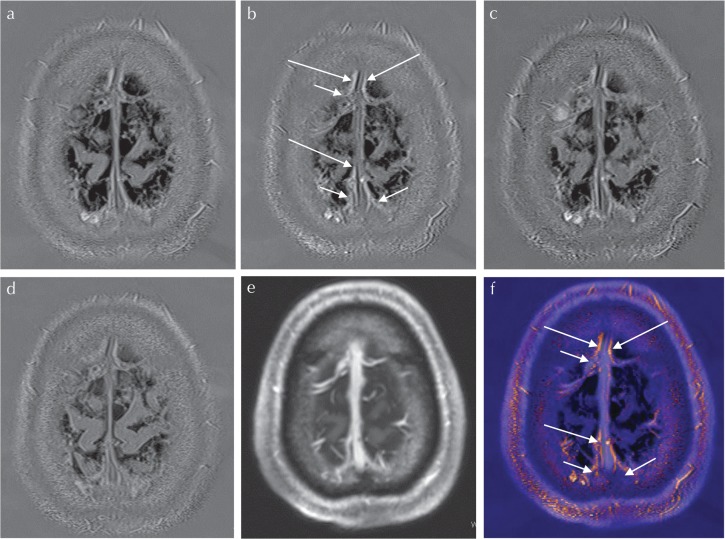Fig. 1.
A 67-year-old man with suspected endolymphatic hydrops underwent a pre- and post-contrast enhanced MR study. 3D-real inversion recovery (IR) images (TR of 15130 ms, TE of 549 ms, inversion delay [TI] of 2700 ms, voxel size of 0.5 × 0.5 × 1.0 mm3, 10 min of acquisition time) were obtained before (a), and at 10 min (b), 4 h (c) and 24 h (d) after intravenous administration of a single dose of gadolinium-based contrast agent (IV-GBCA). The window display level and width were kept constant among (a–d). After 10 min of IV-GBCA, the linear enhancement along the cortical veins and superior sagittal sinus (SSS) can be seen. The linear enhancement along the cortical veins (arrows, b) is presumed to be enhancement of the pial sheath along the cortical veins. The linear enhancement along the SSS (long arrows, b) is presumed to be the previously reported meningeal lymphatics. Magnetization prepared rapid gradient-echo (MP-RAGE, TR of 1570 ms, TE of 2.2 ms, TI of 800 ms, voxel size of 1.0 × 1.0 × 1.0 mm3, flip angle of 15°, 3 min of acquisition time) images were obtained at 7 min after IV-GBCA (e). On the MP-RAGE image, the venous lumen is strongly enhanced. A fusion image between (b) and (e) is shown in (f). The enhanced area of the 3D-real IR is colored. On the fusion image, the linear colored enhancement (arrows, f) is located along the cortical veins and the SSS. The linear colored enhancement is located outside of the venous lumen. The colored linear enhancement along the cortical vein is presumed to be the space between the pial sheath and the cortical venous wall (arrows, f), and appears to continue to the colored enhancements along the SSS (presumed to be the meningeal lymphatics, long arrows, f). This suggests that the space between the pial sheath and the cortical venous wall is connected to the meningeal lymphatics.

